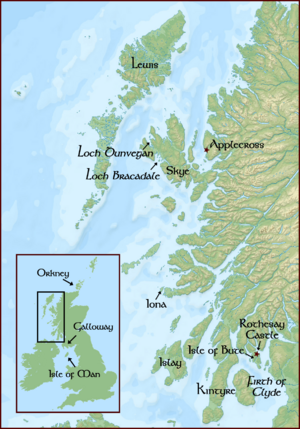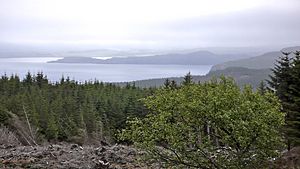Þórkell Þórmóðarson facts for kids
Quick facts for kids
Þórkell Þórmóðarson
|
|
|---|---|
| Died | c. 1230 Vestrajǫrðr, near the Isle of Skye
|
| Cause of death | Killed in battle |
| Children | Three sons, including one named Þórmóðr |
| Parent(s) | Þórmóðr (father) |
| Notes | |
|
Þórkell's sons, and death, are known from Hákonar saga Hákonarsonar; his father's name is known from his patronym
|
|
Þórkell Þórmóðarson was a person mentioned in an old Norse story called Hákonar saga Hákonarsonar. This story was written in the late 1200s. It tells about a big fleet of ships from Norway and the Hebrides (islands off Scotland) that sailed through the Hebrides around the year 1230.
The story says that Þórkell was killed in a battle at a place called Vestrajǫrðr, which was near the Isle of Skye. Two of his sons also died, but a third son, named Þórmóðr, managed to escape. The next year, the fleet sailed north. When it reached the Isle of Lewis, a man named Þórmóðr Þórkelsson had to run away, leaving his wife and belongings behind. Many people think that the Þórmóðr who escaped the battle and the Þórmóðr who fled Lewis were the same person.
Historians aren't sure why Þórkell and Þórmóðr were attacked. One idea is that they supported a different leader, Gofraid Donn, instead of Olaf the Black, who was a powerful king in the area and part of the attacking fleet.
Some people also believe that Þórkell and Þórmóðr might be ancestors of a Scottish family called Clan MacLeod. They think that Þórkell's name is remembered in one part of the clan (Sìol Thorcaill), and Þórmóðr's name in another (Sìol Thormoid).
Contents
What Are the Old Stories About Þórkell?
Þórkell Þórmóðarson is mainly known from the old Norse story Hákonar saga Hákonarsonar. This story was written by Sturla Þórðarson between 1263 and 1284. Sturla used both written records and spoken stories to write it. The saga exists in several old books, like Eirspennill and the Flateyjarbók. Historians believe the Eirspennill version is the most accurate.
What Was Happening in the Isles?
In the early 1100s, the Kingdom of Mann and the Isles included the Hebrides and the Isle of Man. But this kingdom started to have problems. In 1156, a king named Guðrøðr Óláfsson lost control of some islands. After he died in 1187, his sons, Óláfr and Rögnvaldr, fought each other for control. This fighting made the kingdom weak.
In the early 1200s, a powerful Scottish lord named Alan of Galloway wanted to control the Isle of Man. He supported Rögnvaldr against Óláfr. But in 1226, Óláfr took control of the Isle of Man. Because Óláfr couldn't stop the fighting in the Hebrides, Hákon Hákonarson, the King of Norway, decided to get involved. He made Óspakr (a descendant of an earlier leader) a new king in the Isles.
King Hákon gave Óspakr a large fleet of ships to take control of the Scottish islands. Óláfr and his nephew, Guðrøðr, joined this fleet in the spring of 1230. The story says the fleet had eighty ships, which means over three thousand men!
When the fleet reached the southern Hebrides, they captured some enemies of Óláfr. They then attacked the Isle of Bute. Even though they won, they had to retreat because Alan of Galloway was coming with a huge fleet of his own. Óspakr died from his wounds. Óláfr then took command and used the fleet to get back control of the Isle of Man. The fleet stayed there for the winter.
In the spring, they sailed north. They fought a battle on Kintyre and lost many men. Then, in 1231, Guðrøðr was killed on the Isle of Lewis. Óláfr died a few years later in 1237.
What the Saga Says About the Battle
The Eirspennill version of the saga tells us that King Hákon of Norway gave Óspakr the title of "king" and an army for the Hebrides. Óláfr also came to King Hákon, saying he had been driven from the Isle of Man. Óláfr then sailed to Orkney with Páll Bálkason.
Before the main fleet left Orkney, it had grown to twenty ships. Two men, Balki 'the Young' Pálsson and Óttarr Snækollr, heard about this. They sailed south to Skye and found Þórkell Þórmóðarson at Vestrajǫrðr. They fought him there. Þórkell and two of his sons were killed. However, another son, named Þórmóðr, survived by jumping onto a floating barrel and drifting to shore. After their victory, Óttarr and Bálki sailed to meet Óspakr and the rest of the fleet.
After Þórkell's death, the whole fleet sailed to the Sound of Islay. More Hebridean fighters joined them, making the fleet eighty ships strong. They then attacked the Isle of Bute and captured Rothesay Castle, but they lost many men. The fleet sailed to Kintyre, where Óspakr became sick and died. Óláfr then took charge.
The fleet sailed south to the Isle of Man. In the spring, they sailed north again. On Kintyre, they fought a strong group of Scots, and both sides lost many men. After this, the fleet sailed to Lewis. There, they found Þórmóðr Þórkelsson. Þórmóðr fled, and his wife and all his valuables were taken. The Norwegians then went to Orkney, and most of the ships sailed back to Norway. Páll stayed in the Hebrides but was killed a few weeks later.
Was Þórkell Connected to Clan MacLeod?

Some historians, like Thomas in the late 1800s, suggested that Þórmóðr Þórkelsson and Þórkell Þórmóðarson were ancestors of Clan MacLeod. The old Norse names Þórmóðr and Þórkell are the origins of the modern Scottish Gaelic names Tormod and Torcall.
Clan MacLeod traditionally has two main branches: Sìol Thormoid ("Seed of Tormod") and Sìol Thorcaill ("Seed of Torcall"). Sìol Thorcaill was powerful on Lewis, and Sìol Thormoid held lands on western Skye. Clan tradition says these two branches came from two brothers, Torcall and Tormod, who were sons of the clan's founder, Leod. However, today, historians think Torcall was actually Tormod's grandson.
Thomas also thought that the clan's founder was Ljótólfr, a character from another old story, the Orkneyinga saga. Ljótólfr was a nobleman from Lewis in the 1100s. However, most historians now believe the clan's founder was a different man named Leod (whose name comes from Ljótr), who lived about a century later.
Thomas believed that Þórmóðr Þórkelsson was the son of Þórkell Þórmóðarson, and that Þórkell Þórmóðarson was the grandson of Ljótólfr. He noted that the saga says Þórmóðr left his wife and belongings on Lewis, suggesting he lived there. Thomas calculated that Þórkell's father would have been born around the same time Ljótólfr was active on Lewis.
In the 1900s, a scholar named William Matheson suggested that Þórkell might have been related to the MacNicols of Skye. He noted that the name Torquil is found in MacNicol family histories. Tradition says that the MacNicols owned Lewis and Assynt before a MacLeod married a MacNicol heiress and gained their lands. Matheson thought that the first MacLeod named Torquil was the son of this MacNicol heiress.
|



